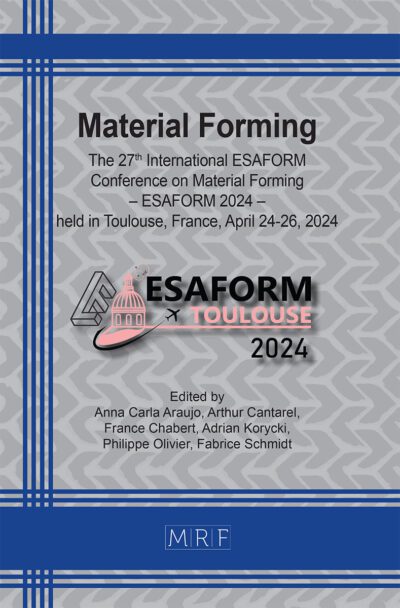Evaluation of plasma cleaning efficiency for surface contaminant removal from AA7075 chips
Chenyang Han, Enrico Simonetto, Andrea Ghiotti, Stefania Bruschi
Abstract. This study presents an experimental method to evaluate the effectiveness of plasma cleaning for removing surface contaminants, including lubricants and oxides, from AA7075 chips obtained in machining operations. A lubricant mixture (3% oil and 97% water) and surface oxides were characterized using various analytical techniques to assess the cleaning performance. The findings demonstrate the potential of plasma treatment as an efficient surface-cleaning method, particularly in enhancing recycling processes for solid metal recovery. Plasma cleaning was shown to significantly reduce organic contamination and oxide layers on the surface of aluminum alloy metal chips. Interestingly, the substrate material (aluminum or plastic) did not significantly influence the cleaning effectiveness. Furthermore, variations in processing durations, from shorter cycles (10 steps) to longer cycles (100 steps), yielded comparable cleaning results. These insights prove the capabilities of plasma cleaning as a viable technique for industrial applications requiring efficient surface decontamination.
Keywords
Aluminum Alloys, Metal Chips Cleaning, Plasma Cleaning
Published online 5/7/2025, 7 pages
Copyright © 2025 by the author(s)
Published under license by Materials Research Forum LLC., Millersville PA, USA
Citation: Chenyang Han, Enrico Simonetto, Andrea Ghiotti, Stefania Bruschi, Evaluation of plasma cleaning efficiency for surface contaminant removal from AA7075 chips, Materials Research Proceedings, Vol. 54, pp 2527-2533, 2025
DOI: https://doi.org/10.21741/9781644903599-273
The article was published as article 273 of the book Material Forming
![]() Content from this work may be used under the terms of the Creative Commons Attribution 3.0 license. Any further distribution of this work must maintain attribution to the author(s) and the title of the work, journal citation and DOI.
Content from this work may be used under the terms of the Creative Commons Attribution 3.0 license. Any further distribution of this work must maintain attribution to the author(s) and the title of the work, journal citation and DOI.
References
[1] Y. M. Altharan, S. Shamsudin, S. Al-Alimi, Y. Saif, and W. Zhou, ‘A review on solid-state recycling of aluminum machining chips and their morphology effect on recycled part quality’, Heliyon, vol. 10, no. 14, p. e34433, Jul. 2024. https://doi.org/10.1016/j.heliyon.2024.e34433
[2] D. Paraskevas, S. Dadbakhsh, J. Vleugels, K. Vanmeensel, W. Dewulf, and J. R. Duflou, ‘Solid state recycling of pure Mg and AZ31 Mg machining chips via spark plasma sintering’, Mater. Des., vol. 109, pp. 520–529, Nov. 2016. https://doi.org/10.1016/j.matdes.2016.07.082
[3] M. Samuel, ‘A new technique for recycling aluminium scrap’, J. Mater. Process. Technol., vol. 135, no. 1, pp. 117–124, Apr. 2003. https://doi.org/10.1016/S0924-0136(02)01133-0
[4] A. Latif, G. Ingarao, and L. Fratini, ‘Multi-material based functionally graded billets manufacturing through friction stir consolidation of aluminium alloys chips’, CIRP Ann., vol. 71, no. 1, pp. 261–264, 2022. https://doi.org/10.1016/j.cirp.2022.03.035
[5] M. Laurent-Brocq et al., ‘Solid state recycling of aluminium chips: Multi-technique characterization and analysis of oxidation’, Materialia, vol. 31, p. 101864, Sep. 2023. https://doi.org/10.1016/j.mtla.2023.101864
[6] Z. Wang, Y. Bao, and M. Wang, ‘The effect of different cleaning methods for titanium chips on the carbon content of ferrotitanium after remelting’, J. Mater. Res. Technol., vol. 18, pp. 2208–2216, May 2022. https://doi.org/10.1016/j.jmrt.2022.03.115
[7] G. Zhang et al., ‘Investigation on mechanism of oxide removal and plasma behavior during laser cleaning on aluminum alloy’, Appl. Surf. Sci., vol. 506, p. 144666, Mar. 2020. https://doi.org/10.1016/j.apsusc.2019.144666
[8] O. Schalm et al., ‘Tarnished silver–copper surfaces reduction using remote helium plasma at atmospheric pressure studied by means of high-resolution synchrotron x-ray photoelectron microscopy’, Corros. Sci., vol. 178, p. 109074, Jan. 2021. https://doi.org/10.1016/j.corsci.2020.109074
[9] A. Surpi et al., ‘HiPIMS deposition of TiOx in an industrial-scale apparatus: Effects of target size and deposition geometry on hysteresis’, Surf. Coat. Technol., vol. 235, pp. 714–719, Nov. 2013. https://doi.org/10.1016/j.surfcoat.2013.08.053
[10] D. Dobras, S. Bruschi, E. Simonetto, M. Rutkowska-Gorczyca, and A. Ghiotti, ‘The Effect of Direct Electric Current on the Plastic Behavior of AA7075 Aluminum Alloy in Different States of Hardening’, Materials, vol. 14, no. 1, p. 73, Dec. 2020. https://doi.org/10.3390/ma14010073














